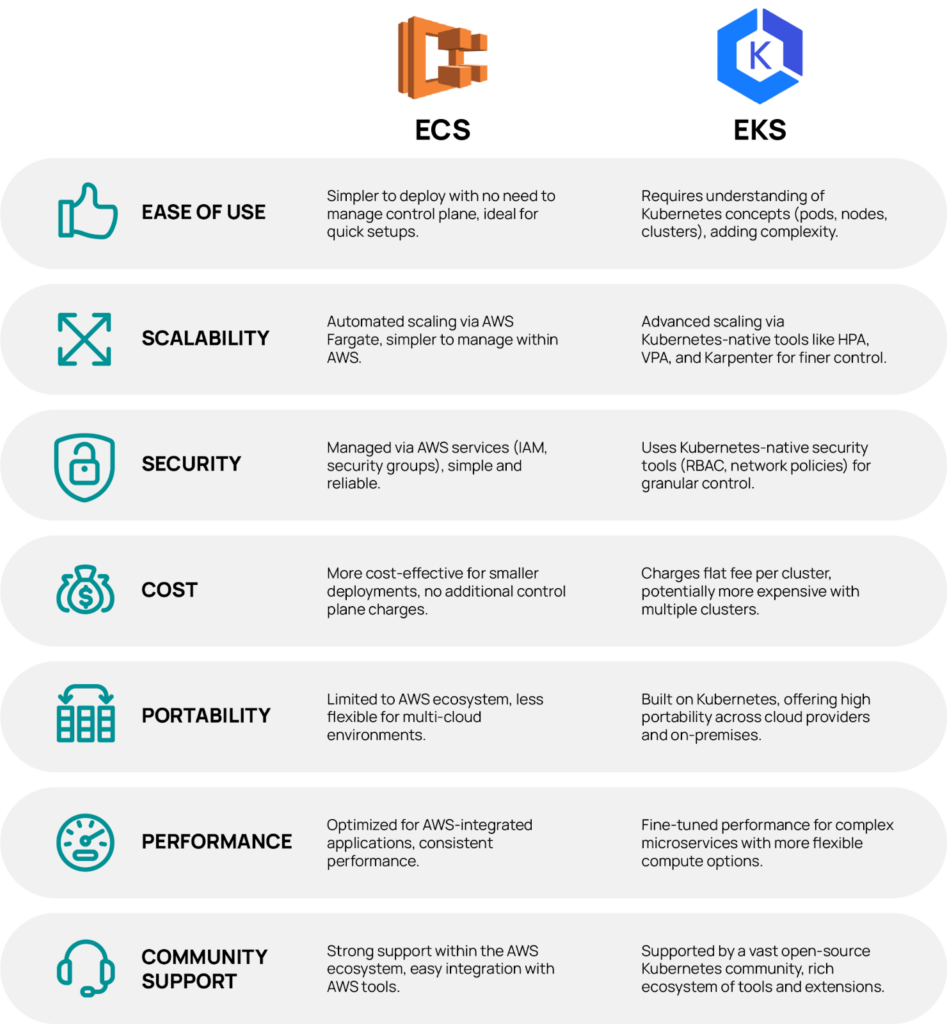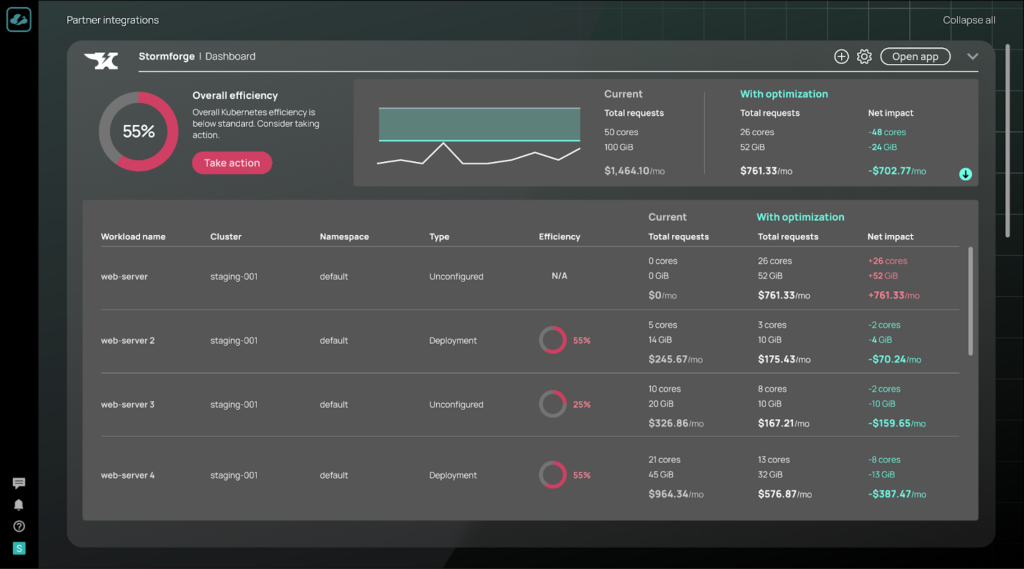ECS vs EKS: A Strategic Decision for Modern Cloud Architecture
As modern applications grow in complexity, organizations are turning to containerization to simplify development, deployment, and scalability. By packaging applications with all their dependencies, containers offer an unprecedented level of consistency and efficiency across environments—from local development to massive cloud-scale production.
With the rise of cloud-native architectures, container orchestration has become the linchpin for managing this evolution, and AWS’s two leading solutions—Amazon Elastic Container Service (ECS) and Amazon Elastic Kubernetes Service (EKS)—present a critical decision point in choosing the right orchestration platform in the ECS vs EKS debate.
In this article, we’ll dive deep into the features, advantages, and use cases of ECS vs EKS, helping you decide which service best suits your organization’s requirements. Additionally, we’ll explore how incorporating advanced optimization solutions can further enhance your container orchestration strategy.
What is Amazon ECS?
Amazon ECS is a fully managed container orchestration service designed to simplify running and managing Docker containers on AWS. It’s tightly integrated with the AWS ecosystem, offering a seamless experience for deploying, managing, and scaling containerized applications. It supports both AWS Fargate, a serverless compute engine, and Amazon EC2, giving you the flexibility to either manage the underlying infrastructure yourself or let AWS handle it.
ECS stands out due to its simplicity and seamless integration with other AWS services like Elastic Load Balancing, IAM (Identity and Access Management), and CloudWatch, offering a streamlined deployment experience. This simplicity is a critical differentiator when comparing ECS vs EKS. Additionally, with AWS Fargate, ECS allows you to run containers without managing the underlying servers, reducing operational overhead. ECS also doesn’t charge for the control plane, making it potentially more cost-effective, especially when using Fargate for resource management.
What is Amazon EKS?
Amazon EKS is a managed Kubernetes service that integrates the power of Kubernetes into AWS, providing a scalable, reliable, and secure environment for running Kubernetes-based applications. It offers flexibility in supporting complex applications and multi-cloud environments and allows you to extend Kubernetes clusters to on-premises environments through EKS Anywhere, enabling you to maintain consistency and seamless management across hybrid cloud architectures.
EKS also supports Kubernetes-native features like Horizontal Pod Autoscaler (HPA), Vertical Pod Autoscaler (VPA), and Karpenter, which is particularly notable for automatically provisioning the right compute resources at the right time. This helps enhance scalability and efficiency, leading to significant performance improvements and cost savings when evaluating ECS vs EKS.
Detailed Comparison: ECS vs EKS
When evaluating ECS vs EKS, several key factors come into play, including ease of use, scalability, security, cost, and performance. Below we explore these aspects to help determine which service best suits your needs.

Ease of Use and Deployment
Because ECS doesn’t require managing a control plane, it allows for quick and easy deployment of containerized applications, streamlining operations for teams prioritizing speed and efficiency. In contrast, EKS requires a deeper understanding of Kubernetes concepts like pods, nodes, and clusters, which adds complexity but offers greater control over the orchestration of containerized workloads. While AWS abstracts much of the complexity, EKS demands more operational expertise than ECS.
Scalability
ECS provides automated scaling with AWS Fargate, allowing you to adjust resources based on demand. This feature simplifies scaling operations, especially within the AWS environment, and may be more straightforward for some teams. EKS, on the other hand, offers advanced scaling capabilities through Kubernetes-native tools, such as HPA and VPA, allowing for more precise control over resource allocation. Karpenter further enhances EKS by enabling automatic resource provisioning, optimizing workload efficiency, and ensuring cost savings.
Security
ECS’s security model, managed through AWS services like IAM roles and security groups, provides robust protection with minimal configuration. Since it’s tightly integrated with AWS, ECS follows AWS’s best security practices. For organizations comparing ECS vs EKS, ECS’s security features are simple and reliable. EKS, on the other hand, leverages Kubernetes’ native security tools, such as Role-Based Access Control (RBAC) and network policies, and provides more granular security controls. This benefits organizations that require fine-tuned security configurations aligned with Kubernetes best practices.
Cost Considerations
ECS is more cost-effective for smaller deployments as there are no additional charges for managing the control plane. With Fargate, you only pay for the resources you use, further optimizing costs. This structure makes ECS a more appealing option for cost-conscious organizations when considering ECS vs EKS. EKS, however, charges a flat fee for each cluster in addition to compute and storage costs, making it potentially more expensive for organizations running multiple clusters. Yet, with the right optimization strategies, including using tools like Karpenter, EKS can also provide cost-efficient scaling and resource management.
Portability and Flexibility
ECS’s tight integration with AWS simplifies deployment but limits portability, making it best suited for organizations that are fully committed to the AWS ecosystem. In contrast, EKS, built on Kubernetes, offers high portability across different environments, including on-premises and other cloud providers. This makes EKS ideal for organizations pursuing multi-cloud strategies.
Performance
Both ECS and EKS offer strong performance, but they cater to different workloads. ECS is optimized for applications that benefit from AWS-managed services and close integration with other AWS products. Its performance is consistent and well-suited to straightforward containerized applications. EKS, however, allows for more fine-tuned performance management, particularly in microservices architectures. Kubernetes’ autoscaling features combined with EKS’s flexibility in compute options (EC2, Fargate, or on-premises) ensure that performance is optimized for complex workloads.
Community and Ecosystem Support
ECS, being a native AWS service, benefits from strong support within the AWS ecosystem. AWS provides extensive documentation, tutorials, and support channels for teams using ECS to efficiently find troubleshooting guidance and resources. ECS also integrates seamlessly with AWS tools, enabling users to leverage the full range of AWS services for managing, monitoring, and scaling their applications.
In contrast, EKS is part of a vast and active open-source community that offers access to a rich ecosystem of tools, extensions, and third-party integrations that extend the functionality of Kubernetes. Additionally, Kubernetes’s open-source nature ensures a wealth of community-driven content, including forums, GitHub repositories, and public support channels. This broad ecosystem makes EKS a highly flexible and extensible solution for organizations that want to tap into the broader Kubernetes community.
ECS vs EKS: Advanced Use Cases
When exploring ECS vs EKS, understanding their use cases can further clarify which service is the better fit.
In hybrid cloud deployments, ECS can extend to on-premises environments using ECS Anywhere, allowing for consistent container management across cloud and on-premises infrastructure. However, EKS excels in hybrid cloud deployments by managing Kubernetes clusters across both cloud and on-premises infrastructure, maintaining flexibility and consistency.
For multi-cloud strategies, EKS’s Kubernetes foundation offers the flexibility to deploy applications across various cloud environments, ensuring consistent management and orchestration. Organizations looking to leverage this multi-cloud flexibility would benefit more from EKS.
For CI/CD pipelines, ECS integrates well with AWS CodePipeline and CodeBuild, providing a straightforward approach for simpler deployments. EKS, however, supports more complex workflows, leveraging Kubernetes-native tools and third-party integrations, making it a preferred choice for more advanced microservices architectures.
Migration Considerations
Transitioning to either ECS or EKS requires careful planning. For organizations already embedded in the AWS ecosystem, ECS offers a more straightforward migration process, especially when using AWS Application Migration Service. Migrating to EKS, however, may require more effort, particularly for teams unfamiliar with Kubernetes. Tools like Helm charts and AWS Migration Hub can assist in easing this transition, though EKS’s inherent complexity adds to the migration workload.
Elevate Your Container Strategy with StormForge and CloudBolt
EKS is a powerful container orchestration service that offers the flexibility and control of Kubernetes, making it the preferred choice for organizations with complex workloads and multi-cloud requirements.

To truly maximize the value of your EKS-based container orchestration strategy, consider integrating the joint optimization solution offered by StormForge and CloudBolt. By leveraging its AI/ML-driven capabilities, you can ensure that your applications run at peak performance, with optimized resource usage and minimized costs.
- Performance Optimization: StormForge’s solution continuously analyzes workload performance in real time, providing recommendations to adjust resources dynamically. This ensures that your EKS environments remain efficient, responsive, and cost-effective.
- Capacity Planning: With the combined capabilities of StormForge and CloudBolt, you can plan capacity with greater accuracy, avoiding the pitfalls of overprovisioning or underprovisioning. Their machine learning algorithms predict future workload demands and adjust resources accordingly, helping you maintain optimal performance without unnecessary expenditure.
- Cost Management: The joint solution extends to cost management, helping you identify and eliminate resource waste. By aligning your cloud resources with actual usage patterns, StormForge and CloudBolt enable you to achieve significant cost savings without compromising performance.
Whether you’re already leveraging Kubernetes’ full power with EKS or are planning to scale, integrating StormForge and CloudBolt into your container orchestration strategy will not only enhance your cloud ROI but also ensure sustained, efficient operations.
Don’t miss the opportunity to elevate your cloud strategy. Schedule a demo with us today and unlock the full potential of EKS with StormForge and CloudBolt.
Related Blogs

The End of Manual Optimization: Why We Acquired StormForge
Today is a big day for CloudBolt—we’ve officially announced our acquisition of StormForge. This marks a major milestone for us…

